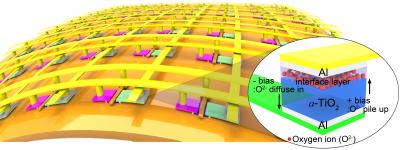Home > Press > A KAIST research team has developed a fully functional flexible memory
 |
| This is a schematic of a fully functional flexible memory array on flexible substrates.
Credit: KAIST |
Abstract:
The team of Professor Keon Jae Lee (Department of Materials Science and Engineering, KAIST) has developed fully functional flexible non-volatile resistive random access memory (RRAM) where a memory cell can be randomly accessed, written, and erased on a plastic substrate.
A KAIST research team has developed a fully functional flexible memory
South Korea | Posted on November 5th, 2011Memory is an essential part in electronic systems, as it is used for data processing, information storage and communication with external devices. Therefore, the development of flexible memory has been a challenge to the realization of flexible electronics.
Although several flexible memory materials have been reported, these devices could not overcome cell-to-cell interference due to their structural and material limitations. In order to solve this problem, switching elements such as transistors must be integrated with the memory elements. Unfortunately, most transistors built on plastic substrates (e.g., organic/oxide transistors) are not capable of achieving the sufficient performance level with which to drive conventional memory. For this reason, random access memory operation on a flexible substrate has not been realized thus far.
Recently, Prof. Lee's research team developed a fully functional flexible memory that is not affected by cell-to-cell interference. They solved the cell-to-cell interference issue by integrating a memristor (a recently spotlighted memory material as next-generation memory elements) with a high-performance single-crystal silicon transistor on flexible substrates. Utilizing these two advanced technologies, they successfully demonstrated that all memory functions in a matrix memory array (writing/reading/erasing) worked perfectly.
Prof. Lee said, "This result represents an exciting technology with the strong potential to realize all flexible electronic systems for the development of a freely bendable and attachable computer in the near future."
This result was published in the October online issue of the Nano Letters ACS journal.
####
For more information, please click here
Contacts:
Lan Yoon
82-423-502-295
Copyright © The Korea Advanced Institute of Science and Technology
If you have a comment, please Contact us.Issuers of news releases, not 7th Wave, Inc. or Nanotechnology Now, are solely responsible for the accuracy of the content.
| Related News Press |
News and information
![]() Simulating magnetization in a Heisenberg quantum spin chain April 5th, 2024
Simulating magnetization in a Heisenberg quantum spin chain April 5th, 2024
![]() NRL charters Navy’s quantum inertial navigation path to reduce drift April 5th, 2024
NRL charters Navy’s quantum inertial navigation path to reduce drift April 5th, 2024
![]() Discovery points path to flash-like memory for storing qubits: Rice find could hasten development of nonvolatile quantum memory April 5th, 2024
Discovery points path to flash-like memory for storing qubits: Rice find could hasten development of nonvolatile quantum memory April 5th, 2024
Chip Technology
![]() Discovery points path to flash-like memory for storing qubits: Rice find could hasten development of nonvolatile quantum memory April 5th, 2024
Discovery points path to flash-like memory for storing qubits: Rice find could hasten development of nonvolatile quantum memory April 5th, 2024
![]() Utilizing palladium for addressing contact issues of buried oxide thin film transistors April 5th, 2024
Utilizing palladium for addressing contact issues of buried oxide thin film transistors April 5th, 2024
![]() HKUST researchers develop new integration technique for efficient coupling of III-V and silicon February 16th, 2024
HKUST researchers develop new integration technique for efficient coupling of III-V and silicon February 16th, 2024
Memory Technology
![]() Utilizing palladium for addressing contact issues of buried oxide thin film transistors April 5th, 2024
Utilizing palladium for addressing contact issues of buried oxide thin film transistors April 5th, 2024
![]() Interdisciplinary: Rice team tackles the future of semiconductors Multiferroics could be the key to ultralow-energy computing October 6th, 2023
Interdisciplinary: Rice team tackles the future of semiconductors Multiferroics could be the key to ultralow-energy computing October 6th, 2023
![]() Researchers discover materials exhibiting huge magnetoresistance June 9th, 2023
Researchers discover materials exhibiting huge magnetoresistance June 9th, 2023
Discoveries
![]() Chemical reactions can scramble quantum information as well as black holes April 5th, 2024
Chemical reactions can scramble quantum information as well as black holes April 5th, 2024
![]() New micromaterial releases nanoparticles that selectively destroy cancer cells April 5th, 2024
New micromaterial releases nanoparticles that selectively destroy cancer cells April 5th, 2024
![]() Utilizing palladium for addressing contact issues of buried oxide thin film transistors April 5th, 2024
Utilizing palladium for addressing contact issues of buried oxide thin film transistors April 5th, 2024
Announcements
![]() NRL charters Navy’s quantum inertial navigation path to reduce drift April 5th, 2024
NRL charters Navy’s quantum inertial navigation path to reduce drift April 5th, 2024
![]() Discovery points path to flash-like memory for storing qubits: Rice find could hasten development of nonvolatile quantum memory April 5th, 2024
Discovery points path to flash-like memory for storing qubits: Rice find could hasten development of nonvolatile quantum memory April 5th, 2024
|
|
||
|
|
||
| The latest news from around the world, FREE | ||
|
|
||
|
|
||
| Premium Products | ||
|
|
||
|
Only the news you want to read!
Learn More |
||
|
|
||
|
Full-service, expert consulting
Learn More |
||
|
|
||








